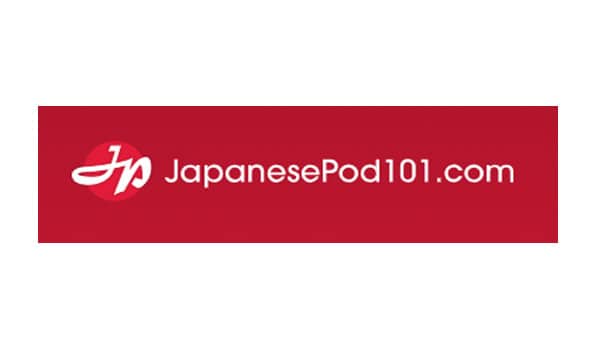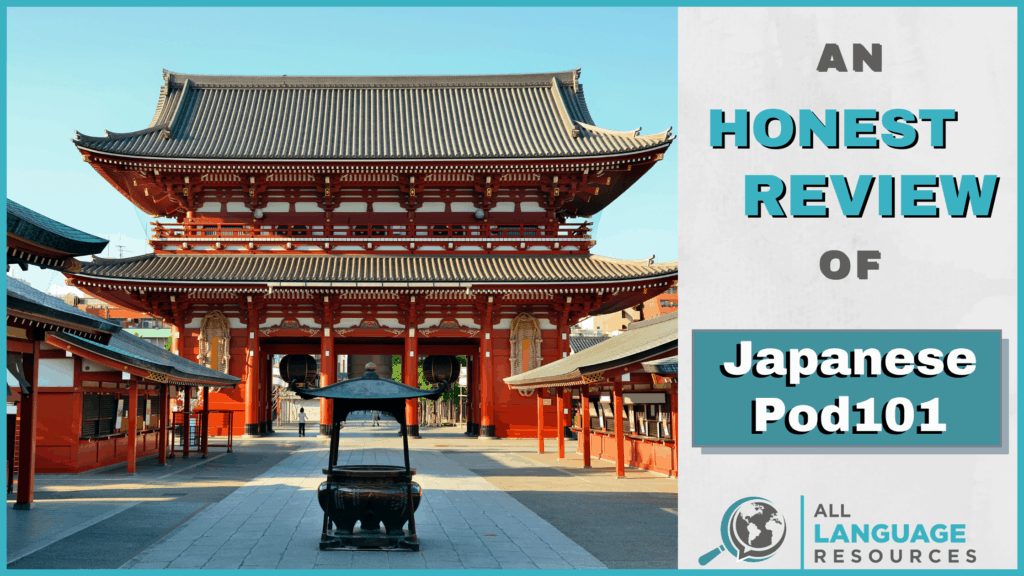JapanesePod101

Summary
JapanesePod101 has thousands of lessons going back over a decade. It’s best used as a supplemental resource to improve your listening comprehension, grammar, and vocabulary. I wouldn’t advise trying to use it as a standalone course because the lessons don’t always follow a clear and suitable path. While very much imperfect, it’s a useful resource and available at an affordable price.
Some lessons are great and others leave a lot to be desired.
A lot of content but it’s not always structured well.
One of the more affordable tools around.
I Like
- Probably the best tool to improve your Japanese listening comprehension.
- Tons of content for everyone from the absolute beginner level up to the intermediate level, though advanced learners would be disappointed.
- Very detailed lesson notes give lots of good information.
I Don’t Like
- The chaotic course structure makes it hard to rely on as your only resource.
- Many of the extra features aren’t useful or very well-made.
- The older lessons can be a lot lower quality.
Price
There are three subscription plans with lengths available from 1 month to 2 years, with many options in between.
Basic – $4/month with Premium $10/month and Premium Plus – $23/month.
Use the coupon code “ALLLANGUAGERESOURCES” to save 25% on a subscription.
JapanesePod101 is one of the better ways to learn Japanese. They have thousands of lessons, from the absolute beginner level, up to an advanced level.
But, it really would work best as a supplemental tool that could be used alongside something like Genki or Minna no Nihongo, and not as a standalone platform.
Despite having a massive library with thousands of lessons, it’s not a resource that you could blindly follow and expect to learn everything you need to know.
They’ve been around for over a decade, and most of the lessons weren’t designed with some sort of master plan in hand. Largely because of this long history, their lessons can feel very scattered and don’t always progress in a manner that would make the most sense to the learner.
There are also lots of topics that have been covered in multiple lessons. The quality, hosts, topics, etc can all vary depending on when the lesson was recorded.
But, despite its flaws, and awful email spamming, JapanesePod101 is actually one of the best resources around for studying Japanese.
At All Language Resources, we’ve already tested and written in-depth reviews of tons of Japanese learning tools and compiled this massive list of over 115 resources for studying the language. This is super important because a resource can’t be judged in isolation. Whether or not to use any given tool depends largely on what the alternatives are.
This in-depth review will take a closer look at what it’s like to use JapanesePod101, including its strengths and weakness, as well as recommending supplemental or alternative resources wherever suitable.
Let’s get into it…
Getting Started with JapanesePod101
You can sign-up for a 7-day free trial without needing to give them any payment information. This gives you complete access to their Premium Plan. But, be prepared, they’ll spam your inbox more than any company I’ve ever seen.
They also try to upsell you constantly, offering lots of discounts and deals along the way. Some are pretty solid value, but they definitely get annoying and give off a bad vibe.
In the process of signing up, you’ll choose your level, though this can be changed at any time.
You’ll find a ton of content at the beginner level, and impressively, there’s a lot of material for intermediate learners as well. This is especially important since it’s harder to find intermediate level listening practice from other places. Unfortunately, the quantity and quality of lessons take a sharp decline when you reach the advanced level.
After signing up, you’ll find yourself at your course dashboard, with a recommended pathway to follow.

Platform and Course Structure
Starting with their recommended pathway isn’t a bad idea, but if you don’t look around carefully, it might be easy to think there’s not anything more available than that.
But, even when you do find all of the other pathways, that only makes things more complicated as there’s no real way to know where to go or when to do what.
I counted 54 different pathways in the absolute beginner level, with the total number of lessons ranging from 5 to over 142.

However, looking at things this way makes it look like they have more lessons than they actually do. This is because a single lesson might appear in a few different pathways. That’s not to say that JapanesePod101 doesn’t have a lot of content, it definitely does, but it’s easy to overestimate the total number of lessons available.
Although you could probably learn just about everything you’d need from JapanesePod101, I wouldn’t recommend trying to do so. There’s just too much lack of continuity from one lesson to the next.
Following JapanesePod101 without any kind of more structured course would make it very easy to leave yourself vulnerable to big gaps in your knowledge, while also spending a lot of time on some less important things.
If you’re expecting JapanesePod101 to be a standalone course, you’re bound to be frustrated and disappointed. But, if you look at it as a supplemental tool to help you primarily with listening practice, grammar and vocabulary, then you’ll likely be satisfied with the content.
Another thing that might cause frustration for some users is that there can be a big difference in the quality of lessons, especially when looking at the older lessons on the platform.
Fortunately, the older lessons are often found within pathways labeled, ‘Classic JPod101.’ This makes them a bit more easily avoided, though they’ll still show up in other pathways as well. The newer content is generally higher quality.
Still though, there are some gems in the older stuff and some duds in the newer ones. You’ll almost certainly want to jump around and try out lots of different pathways.
Use the coupon code “ALLLANGUAGERESOURCES” to save 25% on a subscription.
Lessons
Although JapanesePod101 has both audio and video lessons, I’m primarily going to talk about the audio lessons here. That’s simply because the video lessons are usually not very useful.
Typically, the video lessons are much shorter, lasting only a couple of minutes, though a decent amount of them are longer. Unfortunately, the majority of the video lessons are pretty poorly made, often simply being a presentation from a computer or an uninspiring animation.
A few of the videos can still be pretty interesting or useful, so it may still be worthwhile to try them out. It does feel like finding a good video is like finding a diamond in the rough. They’re there, but there’s a lot of junk to get past.
The audio lessons are a lot more useful than the video ones. For that reason, I’ll focus more on the audio lessons.

There are quite a few different types and lesson structures, but most commonly, they’ll last around 10-15 minutes. These lessons will often be structured in the following manner…
- Introduction to the topic
- Dialogue
- Listen to the dialogue again with line by line translations
- Discussion of key points with explanations and examples
- Grammar discussion
- Listen to dialogue again
Throughout the lessons, you’ll find that the hosts often have a lot of casual chatting between. In one sense, it can be nice as they can be pretty interesting and talk about topics related to Japan. This can be a nice mental break from studying.
But, on the other hand, it limits the amount of Japanese you’ll actually hear in any given lesson. Personally, I’d rather hear more Japanese. After all, you’re here to learn the language, not to listen to the hosts chat about whichever topic.
You are able to listen to the dialogues only if you prefer, which is a solid compromise for people like me.
One thing you’ll also notice is that the lessons contain quite a bit of English, especially at the beginner levels. Fortunately, as you move up levels, more Japanese is spoken in the lessons. This also makes the casual banter between hosts much more enjoyable as it’ll often be in Japanese instead of English.
Each lesson includes very detailed lesson notes which can be downloaded.
These can be very detailed with lots of useful information, such as grammar, vocabulary, important sentence patterns, and a lot more.

Extras Included in the Premium Plan
Basic users will get access to all of the lessons and downloadable lesson notes. But, many of the features are only available if you subscribe to their Premium Plan. There are quite a few premium features, not all of which are useful, so I’ll look at the main ones here.
Lesson Dialogue
This part is very useful. You’ll find the whole dialogue written here with line-by-line audio, making it possible to listen to a single line at a time. It’s a really solid way to go over any parts of the dialogue that may have been challenging for you.
Another great aspect is that you can choose to read it in either Kanji, English, Romaji, or Hiragana.

In addition to being able to play and read individual lines of the dialogue, you can also record yourself and compare it to the original recording.
I like that they give you a format where you can get some listening practice, but it’s not particularly great here. Plus, sometimes the recording can be too long and the time given to record isn’t sufficient.
A much better alternative would be to use Speechling. For free, you can record yourself mimicking sentences of native Japanese speakers. Then, if you’re willing to subscribe, you can submit your recordings to be graded by a teacher and receive feedback on your pronunciation.

Vocabulary
In this section, you’ll find the important vocabulary from the lesson, along with example sentences. Again, you’re given the option to listen to the sentences and record yourself speaking with it. You can also add words to your flashcards from here.

Slideshow
The slideshow isn’t particularly useful. Basically, you’ll listen to a word in Japanese, hear the translation, and then hear a sentence using the word.

Quiz
The quiz is another feature that disappoints. While it sounds really useful, it’s unfortunately limited to being a vocabulary quiz. You can do it with true/false or writing questions.
This would be far more useful if it tested you on your comprehension in some way.

Flashcards and Word Bank
Like you’ll find in lots of language learning resources, JapanesePod101 also offers flashcards that you can use to review.
During your lessons, you’re able to select words from the vocabulary section and add them to either the flashcard deck or the word bank.
Within the flashcards, there are quite a few settings that you can adjust to make them more suitable to your preferences.

I really like that there’s good clear audio recorded and not text-to-speech with all of the words and sentences. It’s great that they’re automatically included here for you, along with a picture and additional example sentences if you’d like. This can really save time and make reviewing very efficient.
There are also lots of pre-made vocabulary lists that can easily be added to either your flashcards or word bank. These lists again give you audio and example sentences, making them more useful than most word lists you’ll find elsewhere.

In the word bank section, you can print off your list or export them. The latter option is pretty useful if you prefer to review with a platform like Anki or Memrise.
Grammar Bank
The grammar bank contains over 400 detailed explanations of various Japanese grammar points. This section can definitely be a useful reference when there’s something that you’d like some clarity on.
However, due to the nature of JapanesePod101’s lessons, you’d probably want to use something like Genki or Minna no Nihongo for a more structured and well-planned out approach. Still, this section can be quite useful.

Plans and Prices
I really dislike the way that JapanesePod101 lists their prices. To me, it feels a bit shady. You’re constantly prompted to upgrade your account and are given the prices shown below.

It’s not until after you give them your payment information that you’re shown that this is only the rate if you subscribe for two years at once. They have several different subscription rates available, between 1 and 24 months long. If you subscribe for one month, the prices are…
Basic – $8/mo
Premium – $25/mo
Premium Plus – $47/mo
What’s included in each plan?
They make it look like each plan includes a ton of different features. Take a look at what’s included in their Premium Plan, but don’t bother trying to read through it all. Much of the features aren’t very useful and/or can be found elsewhere for free.

Here’s a simpler version of the main things included in each plan…
Basic – Lessons and the lesson notes.
Premium – Same as Basic, plus all the features I wrote about earlier.
Premium Plus – Same as Premium but also 1-1 instruction. Surprisingly, they don’t give a lot of details about what’s included with this. But, I’d be shocked if this plan is good value compared to finding a tutor for yourself on italki.
Final Thoughts

JapanesePod101 is an imperfect but still very useful resource.
If you’re expecting it to be a standalone course that covers everything you need to know, in the order you need to know it, then you’ll be disappointed.
It probably shouldn’t be the only resource you use. But, it’s very solid as a supplemental tool that can help you in a number of ways – including improving your listening comprehension, grammar, and vocabulary.
If you’re looking for a more structured course that focuses on the oral language, then Pimsleur might be a good fit for you. Alternatively, there are lots of other solid Japanese courses to choose from.
Still, despite its many imperfections, JapanesePod101 is a solid resource at an affordable price.
If you’re unsure about whether it’s a good fit for you, I’d recommend taking advantage of their 7-day free trial. Just be prepared for their non-stop email spam.
Use the coupon code “ALLLANGUAGERESOURCES” to save 25% on a subscription.


I have a Premium subscription and it’s really helped me with my Japanese study. The trick is to follow the lessons by season, which are easier to locate in Classic Mode on the website or through the Browse Lessons feature of the app, instead of the jumble of pathways as you mentioned. The lessons per season are better structured, with each lesson building on the previous one, and the dialogues work up to a complete storyline, which make them easier to follow along. And while I agree that the vocabulary quiz isn’t very useful, the kanji quiz definitely is.
I also like the extensive example sentences they provide per lesson and the Kana/Romaji/English reading options. I wish they’d provide longer reading passages for beginners, though.
Another excellent review thank you. I took a premium subscription in November and quickly abandoned due to the “chaotic structure” as you say. I was hoping that the “Mastering Japanese Level 1” would be a good start and with structure, but it’s all over the place with no continuity and makes it difficult to figure out if you’re supposed to have already known a word or a particle or a grammar point when it’s used in a lesson. I liked the Hiragana course though, but that’s it. I keep the subscription for now because I want to see if I can use this a bit later when I have a better grasp of Japanese using other tools and resources like yesjapan and pimsleur.